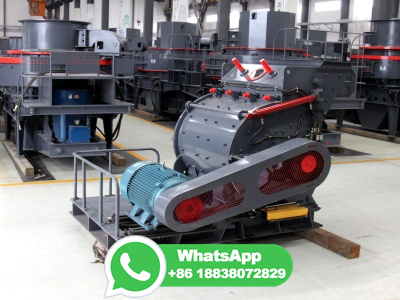
WEBThe next stage in the production chain is the processing of bauxite into alumina, or aluminium oxide Al 2 O 3, a white powder. The most common process for making alumina from bauxite is the Bayer process, which was first discovered over 100 years ago but is still in wide use today. About 90% of alumina refineries in the world use the .
WhatsApp: +86 18203695377
WEBAug 22, 2023 · The Bayer process is used worldwide for the alumina production. This process involves the alkaline leaching of bauxite to extract Al, followed by the precipitation of Al(OH) 3 to recycle the solution [1,2,3].The leaching process results in the formation of a solid residue, commonly referred to as a bauxite residue, which consists of iron .
WhatsApp: +86 18203695377
WEBApr 3, 2023 · Request PDF | A clean twostage Bayer process for achieving nearzero waste discharge from highiron gibbsitic bauxite | The current Bayer process focused on alumina extraction without considering ...
WhatsApp: +86 18203695377
WEBJun 1, 2015 · It is then crushed and washed to remove clay and silica, where this operation is economical, dried, and shipped to the Bayer process refinery. After the bauxite has been removed, the land must be restored to environmentally acceptable grade and contour and the overburden restored. ... bauxite extraction, alumina, and aluminum .
WhatsApp: +86 18203695377
WEBBauxite residue is a byproduct of the Bayer Process. It is primarily composed of the insoluble fraction of the bauxite ore that remains after extraction of the aluminiumcontaining components. Iron oxides (10 – 30%), titanium dioxide (2 – 15%), silicon oxide (5 – 20%) and undissolved alumina (0 – 20%) make up the residue, together with ...
WhatsApp: +86 18203695377
WEBPurifiion of bauxite to fabrie aluminum and, to a lesser extent, alumina, is done by the Bayer process. Bauxite consumption per ton of alumina has increased in recent years (from around tons in 2005) due to declining quality of bauxite resources and now three tons of bauxite are required to produce one ton of alumina and two tons of ...
WhatsApp: +86 18203695377
WEBJun 5, 2020 · The Bayer process for alumina extraction is a chemical process widely used in the industry to produce alumina from bauxite. Bauxite is a sedimentary rock containing high aluminum content. Bauxite is often covered by several meters of rock and clay, which must first be removed before the bauxite can be recovered.
WhatsApp: +86 18203695377
WEBJun 13, 2014 · The first commercial extraction of alumina (Al 2 O 3) from bauxite has been attributed to Henri SainteClaire Deville in about 1854. Soon after this, in 1888, Karl Joseph Bayer described what is now known as the Bayer Process, which led to a dramatic reduction in the cost of aluminum metal.
WhatsApp: +86 18203695377
WEBJun 15, 2023 · The alumina extraction and iron minerals' comprehensive utilization of technology that could replace the current Bayer process have not yet been formed. In the current Bayer digestion process, gibbsitic bauxite was digested at a temperature, alkali concentration, and time of 100–150 °C, 120–190 g/L, and 10–90 min, respectively.
WhatsApp: +86 18203695377
WEBNov 1, 2023 · There are three primary methods for recovering alumina from aluminum ore such as Bayer process, sintered Bayer process and Pedersen process (Safarian and Kolbeinsen, 2016). The summary of these processes are listed in Table 1. Majority of global alumina production is from bauxite ore treatment with Bayer process ( Borra et .
WhatsApp: +86 18203695377
WEBControl the Bayer Process. Red bauxite ore is transformed in the Bayer process to white alumina powder. This is the raw material for the electrometallurgical extraction of Aluminum metal. The yield of the Bayer process is not simply related to the Aluminum grade in Bauxite that is determined by chemical analysis.
WhatsApp: +86 18203695377
WEBAug 1, 2009 · The Bayer process is the principal method for the production of alumina from bauxite worldwide. The modern version of the process (developed in the 1880's) still maintains the key steps of dissolution of aluminarich minerals into hot caustic solution, separation of the insoluble phases, followed by gibbsite precipitation and calcination of .
WhatsApp: +86 18203695377
WEBSep 15, 2022 · The excessive production of bauxite residue (red mud) in the Bayer process is one of the major challenges amongst alumina producers. The Pedersen process is known as a combination of smelting reduction of bauxite and leaching treatment of the produced slag for alumina production, and the process also produces an inert .
WhatsApp: +86 18203695377
WEBNov 11, 2022 · The Bayer process is the most commonly used in alumina production (Liu et al. 2007), and more than 90% of alumina is produced by the Bayer process worldwide (Wang et al. 2018). Bayer red mud is an insoluble alkaline solid waste residue produced during the dissolution process of bauxite by the Bayer process (Zeng et al. 2022; Lyu .
WhatsApp: +86 18203695377
WEBMar 1, 2014 · This paper presents the results of nonlinear statistical modeling of the bauxite leaching process, as part of Bayer. technology for alumina production. Based on the data, collected during the year ...
WhatsApp: +86 18203695377
WEBFeb 3, 2024 · The Bayer process technology is widely used for the industrial production of alumina, however, it is significantly impacted by two important defects: firstly, when using lowgrade ore for production of alumina the economics become very challenging, and secondly, the discharge of large volumes of alkaline red mud (bauxite residue) to the .
WhatsApp: +86 18203695377
WEBSep 1, 2021 · Aluminum production from bauxite is achieved with the Bayer process, which is a hydrometallurgical method. However, in the Bayer process, in time, it is possible to encounter problems such as the ...
WhatsApp: +86 18203695377
WEBIn bauxite residue, hematite, goethite, and zircon host 55%, 25%, and 10% of the total Sc while 2% is hosted in diaspore/boehmite and 1% in titanium phases (Table 5). The remaining 7% of Sc is unaccounted. The effect of the Bayer process to the modes of occurrences of Sc in bauxites is minor.
WhatsApp: +86 18203695377
WEBEvaluation of Bauxite. Extraction. Silica. Residue Separation. Decomposition. Causticization of Sodium Aluminate Liquors. Flow of Fluids. Heat Transfer in the Bayer Process. Discussion. Essential Readings in Light Metals: Alumina and Bauxite, Volume 1. Related; Information; Close Figure Viewer. Return to Figure. Previous Figure Next Figure.
WhatsApp: +86 18203695377
WEBMar 25, 2024 · Recovery of valueadded products from red mud. Bishwambhar Mishra A. Staley D. Kirkpatrick. Environmental Science, Materials Science. 2002. The major waste product of the alkaline extraction of alumina from bauxite (Bayer Process) is known as red mud. Approximately one ton of red mud is produced for every two tons of bauxite .
WhatsApp: +86 18203695377
WEBJun 28, 2023 · The Bayer process is the main method of alumina production worldwide. The use of lowquality bauxites for alumina production results in the formation of a significant amount of technogenic waste—bauxite residue (BR). The Bayer reductive method is one possible way to eliminate BR stockpiling, but it requires highpressure .
WhatsApp: +86 18203695377
WEBThe electrolysis of an electrolyte containing cryolite and alumina to gain molten aluminium. Step 1 of the Bayer Process Crush Bauxite into grains and mix with liquor to form slurry.
WhatsApp: +86 18203695377
WEBSep 28, 2017 · Abstract. The Bayer process is a conventional method for refining bauxite in the production of alumina. The Al/Si ratio in bauxite before feeding to the process must be enriched to more than eight ...
WhatsApp: +86 18203695377
WEBApr 23, 2023 · Aluminum ore, also known as bauxite, is a naturally occurring mineral rock that contains aluminum in the form of aluminum oxide (Al2O3) mixed with various impurities. ... Extraction: Bauxite is extracted through openpit mining, and the ore is then processed through various methods to extract aluminum, such as the Bayer process .
WhatsApp: +86 18203695377
WEBDec 12, 2016 · In this study, extraction of aluminum, iron, and titaniumbearing constituents from diasporetype bauxite ores was investigated by stepwise treatment consisting of predesiliion via alkalileaching of bauxite ore, extraction of alumina via Bayer process, and recovery of iron from red mud via magnetic separation. The pre .
WhatsApp: +86 18203695377
WEBThe Hall–Héroult process is the major industrial process for smelting involves dissolving aluminium oxide (alumina) (obtained most often from bauxite, aluminium's chief ore, through the Bayer process) in molten cryolite and electrolyzing the molten salt bath, typically in a purposebuilt cell. The Hall–Héroult process applied at .
WhatsApp: +86 18203695377
WEBMay 20, 2023 · The flotationBayer process has been widely applied in the alumina refineries, but it introduces large amounts of hazardous organic reagents and produces tailings totaling of about 25% of the initial bauxite ores in weight. 25,26 The lime Bayer process has been also employed to process a portion of highsilica bauxite, but it .
WhatsApp: +86 18203695377
WEBOther articles where Bayer process is discussed: alumina: .extracted from bauxite through the Bayer process, which was developed for the aluminum industry in 1888. In the Bayer process bauxite is crushed, mixed in a solution of sodium hydroxide, and seeded with crystals to precipitate aluminum hydroxide. The hydroxide is heated in a .
WhatsApp: +86 18203695377